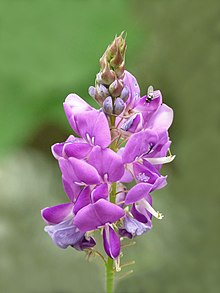|
Desmodium
Desmodium is a genus of plants in the legume family Fabaceae, sometimes called tick-trefoil, tick clover, hitch hikers or beggar lice.[2] There are dozens of species and the delimitation of the genus has shifted much over time. Species are distributed widely – from Quebec to northern Argentina in the Americas, across northern and southern tropical Africa, in the southern Arabian Peninsula, in Myanmar and Thailand, New Guinea, and northern and eastern Australia.[1] Description   These are mostly inconspicuous plants; few have bright or large flowers. Though some can become sizeable plants, most are herbs or small shrubs. Their fruit are loments, meaning each seed is dispersed individually enclosed in its segment. This makes them tenacious plants and some species are considered weeds in places. UsesSeveral Desmodium species release organic compounds, aerially and into the soil, which make them useful for agriculture: Allelopathic compounds are used there via push-pull technology. For this Desmodium heterocarpon, Desmodium intortum, and Desmodium uncinatum are inter-cropped in maize and sorghum fields to suppress witchweeds, including Asiatic witchweed (Striga asiatica) and purple witchweed (S. hermonthica) and to repel Chilo partellus, a stem-boring grass moth.[3] Insects (including pests) are likewise repelled by high amounts of antixenotic allomones produced by Desmodium. A blue dye is obtained from Desmodium incanum. Tick-trefoils in agriculture can also be used as living mulch and as green manure, as they improve soil fertility via nitrogen fixation. Most also make good fodder for animals including bobwhite, turkey, grouse, deer, cattle and goats.[3][4][5] Wild-living, non-farmed deer appear to rely on Desmodium species in certain areas, particularly during the more stressful summer months. The caterpillars of the lesser grass blue (Zizina otis) and the two-barred flasher (Astraptes fulgerator) feed on tick-trefoils. AlkaloidsSome Desmodium species have formerly been known to contain high amounts of tryptamine alkaloids, but many of the tryptamine-containing species have since been transferred to other genera.[3] Taxonomy and systematicsThe taxonomy and systematics of the many dozens of Desmodium species are confusing and unresolved. Related genera such as Codariocalyx, Hylodesmum, Lespedeza, Ohwia, and Phyllodium were and sometimes still are included in Desmodium.[6] Taxonomic authorities commonly disagree about the naming and placement of species. For example, Desmodium spirale as described by August Grisebach might refer to a distinct species, but its validity is doubtful. The "Desmodium spirale" of other authorities may refer to D. neomexicanum, D. ospriostreblum, or D. procumbens. Similarly, the plant originally described as D. podocarpum by A. P. de Candolle is Hylodesmum podocarpum today, but "Desmodium podocarpum" might also refer to D. hookerianum or Hylodesmum laxum, depending on the taxonomic authority.[6] Selected species
Formerly placed here

References
External linksWikimedia Commons has media related to Desmodium. Wikispecies has information related to Desmodium.
|
||||||||||||||||||||||||||||||||||||||
